Starbucks: Marketing Strategy Development & Implementation Report
VerifiedAdded on 2023/06/07
|28
|8423
|202
Report
AI Summary
This report examines the marketing strategy development and implementation of Starbucks, a leading global coffee brand. It delves into the company's background, highlighting its product and customer-oriented approach. The report reviews existing literature on marketing strategy, competitive advantage, and the marketing mix. It employs a case study methodology, using secondary data for analysis, including a SWOT analysis and examination of the 4Ps of marketing. The findings reflect on Starbucks' strengths and weaknesses in its marketing efforts, competitive positioning, and customer retention. The report concludes with recommendations for improving Starbucks' marketing strategy and implementation, focusing on innovation, competitive positioning, and customer engagement. Desklib provides students access to similar reports and study tools.

Running head: FINAL PROJECT REPORT
Marketing strategy development and implementation for Starbucks
Name of the student
Name of the university
Marketing strategy development and implementation for Starbucks
Name of the student
Name of the university
Paraphrase This Document
Need a fresh take? Get an instant paraphrase of this document with our AI Paraphraser

1FINAL PROJECT REPORT
Executive summary
The aim of this paper is to study the marketing strategy and implementation tactics of
Starbucks. Starbucks is at present one of the most popular coffee brands in the world at
present. The paper attempts to study the marketing strategy of Starbucks and also
highlights issues with the marketing tactics of the company. The paper is divided into
five chapters. The first chapter introduces the topic and provides a background of the
company that the paper will analyze. The second chapter will study existing literature on
the topic, so as to gain better understanding of the involved concepts and theories. The
third chapter presents the research method and the research philosophy which will be
used to carry out the research. The fourth chapter is data collection, which lists how the
data will be collected and analyzed. A presentation of findings has also been provided.
Finally, the paper concludes by presenting a number of recommendations for Starbucks
to improve its marketing strategy and implementation.
Executive summary
The aim of this paper is to study the marketing strategy and implementation tactics of
Starbucks. Starbucks is at present one of the most popular coffee brands in the world at
present. The paper attempts to study the marketing strategy of Starbucks and also
highlights issues with the marketing tactics of the company. The paper is divided into
five chapters. The first chapter introduces the topic and provides a background of the
company that the paper will analyze. The second chapter will study existing literature on
the topic, so as to gain better understanding of the involved concepts and theories. The
third chapter presents the research method and the research philosophy which will be
used to carry out the research. The fourth chapter is data collection, which lists how the
data will be collected and analyzed. A presentation of findings has also been provided.
Finally, the paper concludes by presenting a number of recommendations for Starbucks
to improve its marketing strategy and implementation.
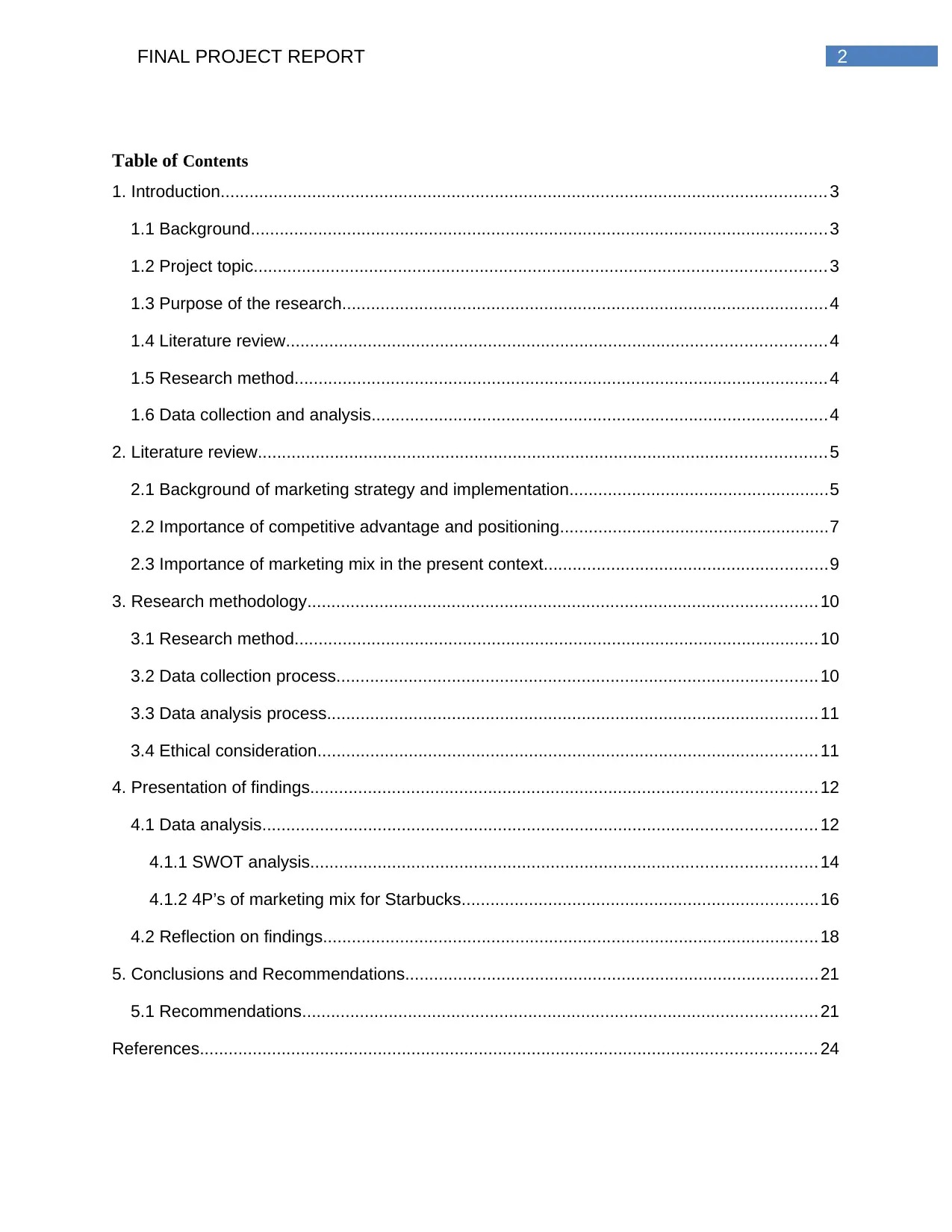
2FINAL PROJECT REPORT
Table of Contents
1. Introduction.............................................................................................................................. 3
1.1 Background........................................................................................................................ 3
1.2 Project topic....................................................................................................................... 3
1.3 Purpose of the research.....................................................................................................4
1.4 Literature review................................................................................................................4
1.5 Research method............................................................................................................... 4
1.6 Data collection and analysis...............................................................................................4
2. Literature review...................................................................................................................... 5
2.1 Background of marketing strategy and implementation......................................................5
2.2 Importance of competitive advantage and positioning........................................................7
2.3 Importance of marketing mix in the present context...........................................................9
3. Research methodology..........................................................................................................10
3.1 Research method............................................................................................................. 10
3.2 Data collection process....................................................................................................10
3.3 Data analysis process......................................................................................................11
3.4 Ethical consideration........................................................................................................11
4. Presentation of findings.........................................................................................................12
4.1 Data analysis................................................................................................................... 12
4.1.1 SWOT analysis.........................................................................................................14
4.1.2 4P’s of marketing mix for Starbucks..........................................................................16
4.2 Reflection on findings.......................................................................................................18
5. Conclusions and Recommendations......................................................................................21
5.1 Recommendations...........................................................................................................21
References................................................................................................................................ 24
Table of Contents
1. Introduction.............................................................................................................................. 3
1.1 Background........................................................................................................................ 3
1.2 Project topic....................................................................................................................... 3
1.3 Purpose of the research.....................................................................................................4
1.4 Literature review................................................................................................................4
1.5 Research method............................................................................................................... 4
1.6 Data collection and analysis...............................................................................................4
2. Literature review...................................................................................................................... 5
2.1 Background of marketing strategy and implementation......................................................5
2.2 Importance of competitive advantage and positioning........................................................7
2.3 Importance of marketing mix in the present context...........................................................9
3. Research methodology..........................................................................................................10
3.1 Research method............................................................................................................. 10
3.2 Data collection process....................................................................................................10
3.3 Data analysis process......................................................................................................11
3.4 Ethical consideration........................................................................................................11
4. Presentation of findings.........................................................................................................12
4.1 Data analysis................................................................................................................... 12
4.1.1 SWOT analysis.........................................................................................................14
4.1.2 4P’s of marketing mix for Starbucks..........................................................................16
4.2 Reflection on findings.......................................................................................................18
5. Conclusions and Recommendations......................................................................................21
5.1 Recommendations...........................................................................................................21
References................................................................................................................................ 24
⊘ This is a preview!⊘
Do you want full access?
Subscribe today to unlock all pages.

Trusted by 1+ million students worldwide
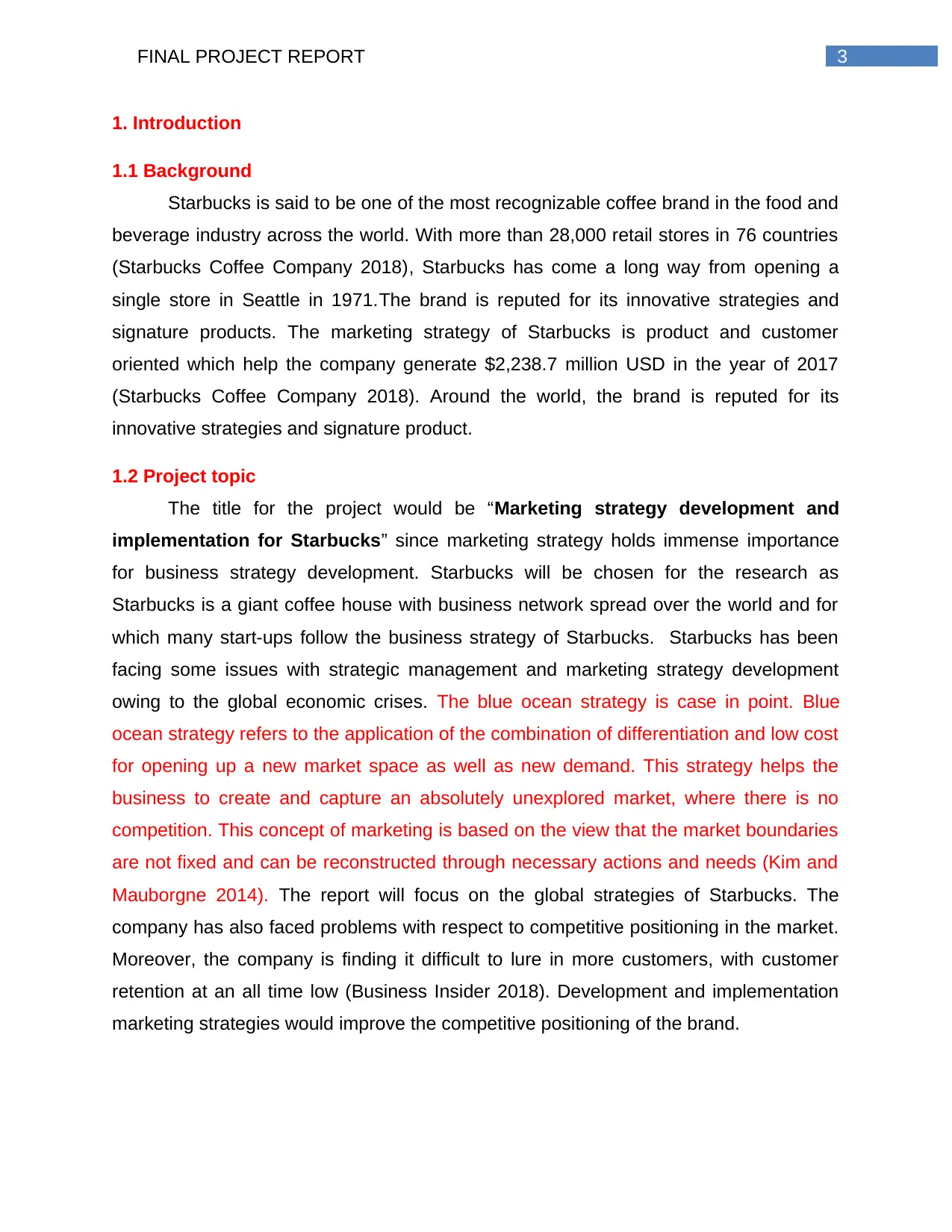
3FINAL PROJECT REPORT
1. Introduction
1.1 Background
Starbucks is said to be one of the most recognizable coffee brand in the food and
beverage industry across the world. With more than 28,000 retail stores in 76 countries
(Starbucks Coffee Company 2018), Starbucks has come a long way from opening a
single store in Seattle in 1971.The brand is reputed for its innovative strategies and
signature products. The marketing strategy of Starbucks is product and customer
oriented which help the company generate $2,238.7 million USD in the year of 2017
(Starbucks Coffee Company 2018). Around the world, the brand is reputed for its
innovative strategies and signature product.
1.2 Project topic
The title for the project would be “Marketing strategy development and
implementation for Starbucks” since marketing strategy holds immense importance
for business strategy development. Starbucks will be chosen for the research as
Starbucks is a giant coffee house with business network spread over the world and for
which many start-ups follow the business strategy of Starbucks. Starbucks has been
facing some issues with strategic management and marketing strategy development
owing to the global economic crises. The blue ocean strategy is case in point. Blue
ocean strategy refers to the application of the combination of differentiation and low cost
for opening up a new market space as well as new demand. This strategy helps the
business to create and capture an absolutely unexplored market, where there is no
competition. This concept of marketing is based on the view that the market boundaries
are not fixed and can be reconstructed through necessary actions and needs (Kim and
Mauborgne 2014). The report will focus on the global strategies of Starbucks. The
company has also faced problems with respect to competitive positioning in the market.
Moreover, the company is finding it difficult to lure in more customers, with customer
retention at an all time low (Business Insider 2018). Development and implementation
marketing strategies would improve the competitive positioning of the brand.
1. Introduction
1.1 Background
Starbucks is said to be one of the most recognizable coffee brand in the food and
beverage industry across the world. With more than 28,000 retail stores in 76 countries
(Starbucks Coffee Company 2018), Starbucks has come a long way from opening a
single store in Seattle in 1971.The brand is reputed for its innovative strategies and
signature products. The marketing strategy of Starbucks is product and customer
oriented which help the company generate $2,238.7 million USD in the year of 2017
(Starbucks Coffee Company 2018). Around the world, the brand is reputed for its
innovative strategies and signature product.
1.2 Project topic
The title for the project would be “Marketing strategy development and
implementation for Starbucks” since marketing strategy holds immense importance
for business strategy development. Starbucks will be chosen for the research as
Starbucks is a giant coffee house with business network spread over the world and for
which many start-ups follow the business strategy of Starbucks. Starbucks has been
facing some issues with strategic management and marketing strategy development
owing to the global economic crises. The blue ocean strategy is case in point. Blue
ocean strategy refers to the application of the combination of differentiation and low cost
for opening up a new market space as well as new demand. This strategy helps the
business to create and capture an absolutely unexplored market, where there is no
competition. This concept of marketing is based on the view that the market boundaries
are not fixed and can be reconstructed through necessary actions and needs (Kim and
Mauborgne 2014). The report will focus on the global strategies of Starbucks. The
company has also faced problems with respect to competitive positioning in the market.
Moreover, the company is finding it difficult to lure in more customers, with customer
retention at an all time low (Business Insider 2018). Development and implementation
marketing strategies would improve the competitive positioning of the brand.
Paraphrase This Document
Need a fresh take? Get an instant paraphrase of this document with our AI Paraphraser
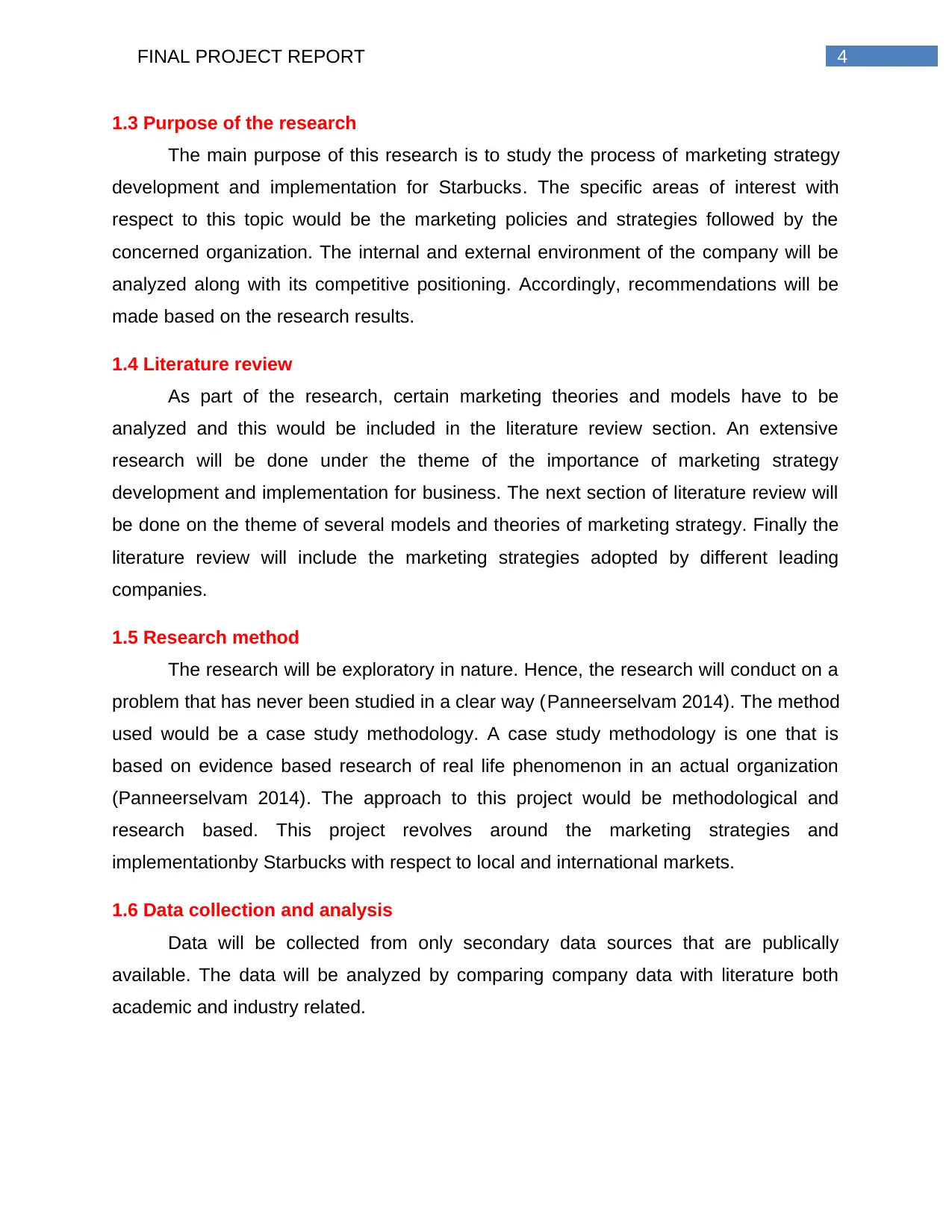
4FINAL PROJECT REPORT
1.3 Purpose of the research
The main purpose of this research is to study the process of marketing strategy
development and implementation for Starbucks. The specific areas of interest with
respect to this topic would be the marketing policies and strategies followed by the
concerned organization. The internal and external environment of the company will be
analyzed along with its competitive positioning. Accordingly, recommendations will be
made based on the research results.
1.4 Literature review
As part of the research, certain marketing theories and models have to be
analyzed and this would be included in the literature review section. An extensive
research will be done under the theme of the importance of marketing strategy
development and implementation for business. The next section of literature review will
be done on the theme of several models and theories of marketing strategy. Finally the
literature review will include the marketing strategies adopted by different leading
companies.
1.5 Research method
The research will be exploratory in nature. Hence, the research will conduct on a
problem that has never been studied in a clear way (Panneerselvam 2014). The method
used would be a case study methodology. A case study methodology is one that is
based on evidence based research of real life phenomenon in an actual organization
(Panneerselvam 2014). The approach to this project would be methodological and
research based. This project revolves around the marketing strategies and
implementationby Starbucks with respect to local and international markets.
1.6 Data collection and analysis
Data will be collected from only secondary data sources that are publically
available. The data will be analyzed by comparing company data with literature both
academic and industry related.
1.3 Purpose of the research
The main purpose of this research is to study the process of marketing strategy
development and implementation for Starbucks. The specific areas of interest with
respect to this topic would be the marketing policies and strategies followed by the
concerned organization. The internal and external environment of the company will be
analyzed along with its competitive positioning. Accordingly, recommendations will be
made based on the research results.
1.4 Literature review
As part of the research, certain marketing theories and models have to be
analyzed and this would be included in the literature review section. An extensive
research will be done under the theme of the importance of marketing strategy
development and implementation for business. The next section of literature review will
be done on the theme of several models and theories of marketing strategy. Finally the
literature review will include the marketing strategies adopted by different leading
companies.
1.5 Research method
The research will be exploratory in nature. Hence, the research will conduct on a
problem that has never been studied in a clear way (Panneerselvam 2014). The method
used would be a case study methodology. A case study methodology is one that is
based on evidence based research of real life phenomenon in an actual organization
(Panneerselvam 2014). The approach to this project would be methodological and
research based. This project revolves around the marketing strategies and
implementationby Starbucks with respect to local and international markets.
1.6 Data collection and analysis
Data will be collected from only secondary data sources that are publically
available. The data will be analyzed by comparing company data with literature both
academic and industry related.
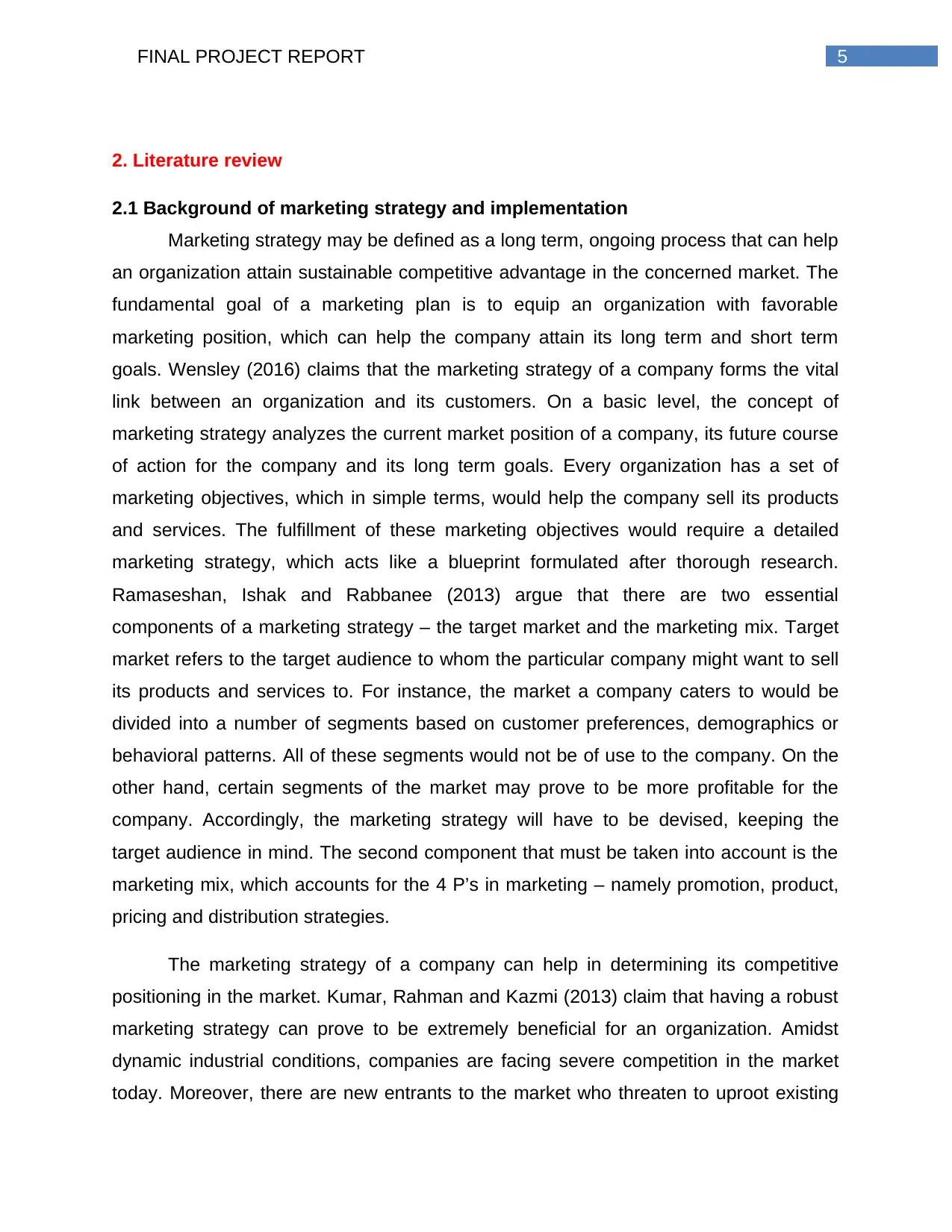
5FINAL PROJECT REPORT
2. Literature review
2.1 Background of marketing strategy and implementation
Marketing strategy may be defined as a long term, ongoing process that can help
an organization attain sustainable competitive advantage in the concerned market. The
fundamental goal of a marketing plan is to equip an organization with favorable
marketing position, which can help the company attain its long term and short term
goals. Wensley (2016) claims that the marketing strategy of a company forms the vital
link between an organization and its customers. On a basic level, the concept of
marketing strategy analyzes the current market position of a company, its future course
of action for the company and its long term goals. Every organization has a set of
marketing objectives, which in simple terms, would help the company sell its products
and services. The fulfillment of these marketing objectives would require a detailed
marketing strategy, which acts like a blueprint formulated after thorough research.
Ramaseshan, Ishak and Rabbanee (2013) argue that there are two essential
components of a marketing strategy – the target market and the marketing mix. Target
market refers to the target audience to whom the particular company might want to sell
its products and services to. For instance, the market a company caters to would be
divided into a number of segments based on customer preferences, demographics or
behavioral patterns. All of these segments would not be of use to the company. On the
other hand, certain segments of the market may prove to be more profitable for the
company. Accordingly, the marketing strategy will have to be devised, keeping the
target audience in mind. The second component that must be taken into account is the
marketing mix, which accounts for the 4 P’s in marketing – namely promotion, product,
pricing and distribution strategies.
The marketing strategy of a company can help in determining its competitive
positioning in the market. Kumar, Rahman and Kazmi (2013) claim that having a robust
marketing strategy can prove to be extremely beneficial for an organization. Amidst
dynamic industrial conditions, companies are facing severe competition in the market
today. Moreover, there are new entrants to the market who threaten to uproot existing
2. Literature review
2.1 Background of marketing strategy and implementation
Marketing strategy may be defined as a long term, ongoing process that can help
an organization attain sustainable competitive advantage in the concerned market. The
fundamental goal of a marketing plan is to equip an organization with favorable
marketing position, which can help the company attain its long term and short term
goals. Wensley (2016) claims that the marketing strategy of a company forms the vital
link between an organization and its customers. On a basic level, the concept of
marketing strategy analyzes the current market position of a company, its future course
of action for the company and its long term goals. Every organization has a set of
marketing objectives, which in simple terms, would help the company sell its products
and services. The fulfillment of these marketing objectives would require a detailed
marketing strategy, which acts like a blueprint formulated after thorough research.
Ramaseshan, Ishak and Rabbanee (2013) argue that there are two essential
components of a marketing strategy – the target market and the marketing mix. Target
market refers to the target audience to whom the particular company might want to sell
its products and services to. For instance, the market a company caters to would be
divided into a number of segments based on customer preferences, demographics or
behavioral patterns. All of these segments would not be of use to the company. On the
other hand, certain segments of the market may prove to be more profitable for the
company. Accordingly, the marketing strategy will have to be devised, keeping the
target audience in mind. The second component that must be taken into account is the
marketing mix, which accounts for the 4 P’s in marketing – namely promotion, product,
pricing and distribution strategies.
The marketing strategy of a company can help in determining its competitive
positioning in the market. Kumar, Rahman and Kazmi (2013) claim that having a robust
marketing strategy can prove to be extremely beneficial for an organization. Amidst
dynamic industrial conditions, companies are facing severe competition in the market
today. Moreover, there are new entrants to the market who threaten to uproot existing
⊘ This is a preview!⊘
Do you want full access?
Subscribe today to unlock all pages.

Trusted by 1+ million students worldwide
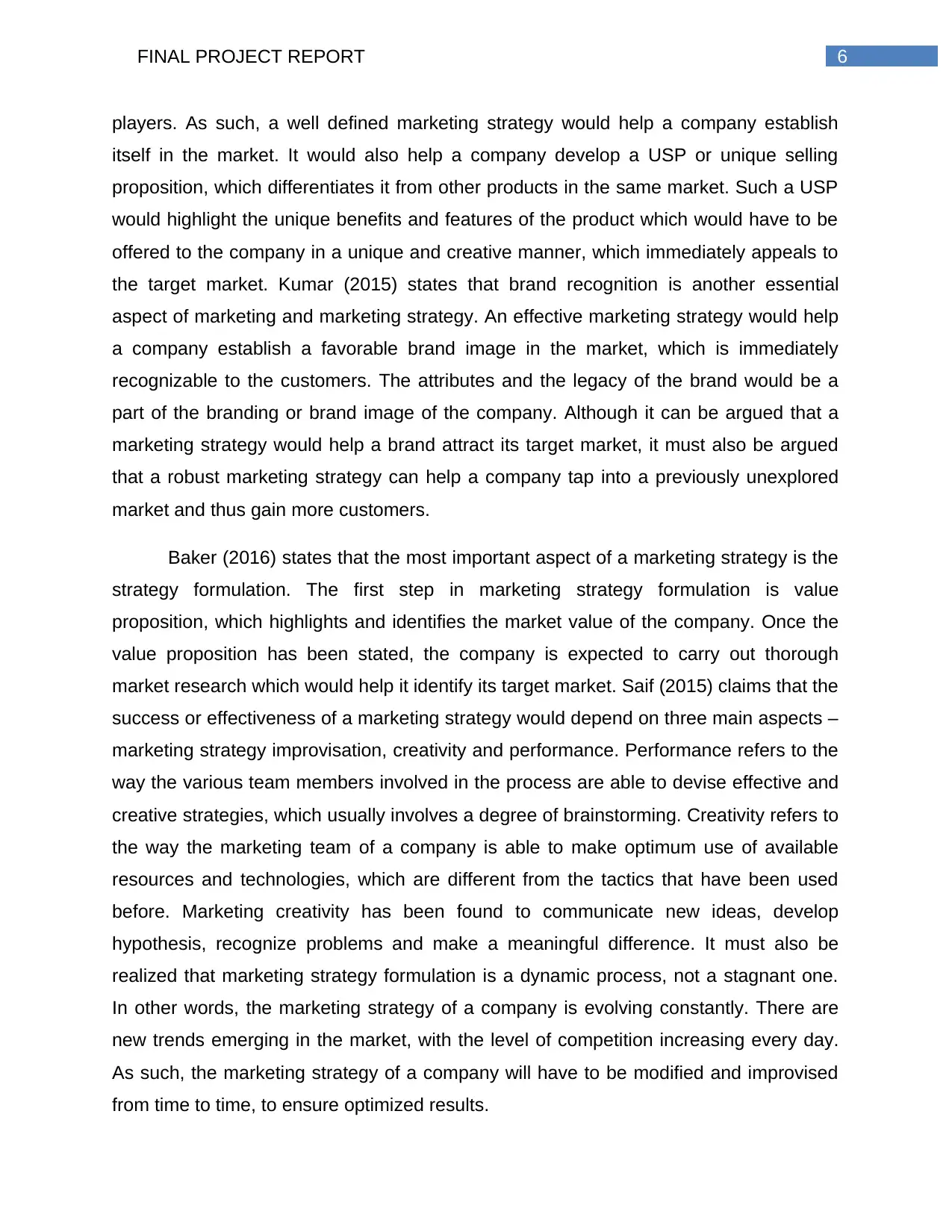
6FINAL PROJECT REPORT
players. As such, a well defined marketing strategy would help a company establish
itself in the market. It would also help a company develop a USP or unique selling
proposition, which differentiates it from other products in the same market. Such a USP
would highlight the unique benefits and features of the product which would have to be
offered to the company in a unique and creative manner, which immediately appeals to
the target market. Kumar (2015) states that brand recognition is another essential
aspect of marketing and marketing strategy. An effective marketing strategy would help
a company establish a favorable brand image in the market, which is immediately
recognizable to the customers. The attributes and the legacy of the brand would be a
part of the branding or brand image of the company. Although it can be argued that a
marketing strategy would help a brand attract its target market, it must also be argued
that a robust marketing strategy can help a company tap into a previously unexplored
market and thus gain more customers.
Baker (2016) states that the most important aspect of a marketing strategy is the
strategy formulation. The first step in marketing strategy formulation is value
proposition, which highlights and identifies the market value of the company. Once the
value proposition has been stated, the company is expected to carry out thorough
market research which would help it identify its target market. Saif (2015) claims that the
success or effectiveness of a marketing strategy would depend on three main aspects –
marketing strategy improvisation, creativity and performance. Performance refers to the
way the various team members involved in the process are able to devise effective and
creative strategies, which usually involves a degree of brainstorming. Creativity refers to
the way the marketing team of a company is able to make optimum use of available
resources and technologies, which are different from the tactics that have been used
before. Marketing creativity has been found to communicate new ideas, develop
hypothesis, recognize problems and make a meaningful difference. It must also be
realized that marketing strategy formulation is a dynamic process, not a stagnant one.
In other words, the marketing strategy of a company is evolving constantly. There are
new trends emerging in the market, with the level of competition increasing every day.
As such, the marketing strategy of a company will have to be modified and improvised
from time to time, to ensure optimized results.
players. As such, a well defined marketing strategy would help a company establish
itself in the market. It would also help a company develop a USP or unique selling
proposition, which differentiates it from other products in the same market. Such a USP
would highlight the unique benefits and features of the product which would have to be
offered to the company in a unique and creative manner, which immediately appeals to
the target market. Kumar (2015) states that brand recognition is another essential
aspect of marketing and marketing strategy. An effective marketing strategy would help
a company establish a favorable brand image in the market, which is immediately
recognizable to the customers. The attributes and the legacy of the brand would be a
part of the branding or brand image of the company. Although it can be argued that a
marketing strategy would help a brand attract its target market, it must also be argued
that a robust marketing strategy can help a company tap into a previously unexplored
market and thus gain more customers.
Baker (2016) states that the most important aspect of a marketing strategy is the
strategy formulation. The first step in marketing strategy formulation is value
proposition, which highlights and identifies the market value of the company. Once the
value proposition has been stated, the company is expected to carry out thorough
market research which would help it identify its target market. Saif (2015) claims that the
success or effectiveness of a marketing strategy would depend on three main aspects –
marketing strategy improvisation, creativity and performance. Performance refers to the
way the various team members involved in the process are able to devise effective and
creative strategies, which usually involves a degree of brainstorming. Creativity refers to
the way the marketing team of a company is able to make optimum use of available
resources and technologies, which are different from the tactics that have been used
before. Marketing creativity has been found to communicate new ideas, develop
hypothesis, recognize problems and make a meaningful difference. It must also be
realized that marketing strategy formulation is a dynamic process, not a stagnant one.
In other words, the marketing strategy of a company is evolving constantly. There are
new trends emerging in the market, with the level of competition increasing every day.
As such, the marketing strategy of a company will have to be modified and improvised
from time to time, to ensure optimized results.
Paraphrase This Document
Need a fresh take? Get an instant paraphrase of this document with our AI Paraphraser

7FINAL PROJECT REPORT
2.2 Importance of competitive advantage and positioning
The marketing strategy of any organization would contribute to its overall
competitive positioning. As Urbancova (2013) states, competitive positioning would
ensure that the organization in question stands head and shoulders above the rest of
the companies in the same industry. A company can hope to succeed in the market only
if it can establish itself as unique and different from the other companies in the same
field, or its rivals. This is also known as strategic competition, which entails devising
new ways and methods of wooing customers and luring them or coming up with
innovative new ways of meeting customer needs. The sustainability or profitability of a
company would depend not on how it is able to perform in the market but on how it
performs in the market with respect to its rivals. The global economy at present is in a
very volatile state, which has proved to be quite challenging for most firms. The
continuously changing global scenario makes it nearly impossible for companies to
sustain their competitive advantage on a long term basis. Zikmund et al. (2013) opined
that for a company to keep up with the pace of the changing marketing trends, the
marketing strategy of any organization would have to be reviewed and monitored at
regular intervals, their effectiveness would have to be assessed and new trends in
political, social, technological and economic realities will have to be considered. Marchi,
Maria and Micelli (2013) are of the opinion that the intensity of the competition that a
company experiences along with the speed at which the competition presents itself
plays a crucial role in determining the competitive advantage of a company.
One of the most important aspects of competitive advantage is sustainability.
According to Kumar and Pansari (2016), a marketing strategy can be called successful
only if it proves itself sustainable over a prolonged period of time. Various other
concepts in marketing like superior performance, strategy and planning, core
competencies, innovation and the integration and implementation of marketing strategy
would determine its competitive positioning. Most importantly, it can be said that the
sustainability of a marketing strategy would depend on how an organization is able to
surpass a company or organization in the same industry which has been around for a
prolonged period of time. Abdul Jalal, Toulson and Tweed (2013) have stated that there
are essentially a few types of competitive advantage that a company can have over
2.2 Importance of competitive advantage and positioning
The marketing strategy of any organization would contribute to its overall
competitive positioning. As Urbancova (2013) states, competitive positioning would
ensure that the organization in question stands head and shoulders above the rest of
the companies in the same industry. A company can hope to succeed in the market only
if it can establish itself as unique and different from the other companies in the same
field, or its rivals. This is also known as strategic competition, which entails devising
new ways and methods of wooing customers and luring them or coming up with
innovative new ways of meeting customer needs. The sustainability or profitability of a
company would depend not on how it is able to perform in the market but on how it
performs in the market with respect to its rivals. The global economy at present is in a
very volatile state, which has proved to be quite challenging for most firms. The
continuously changing global scenario makes it nearly impossible for companies to
sustain their competitive advantage on a long term basis. Zikmund et al. (2013) opined
that for a company to keep up with the pace of the changing marketing trends, the
marketing strategy of any organization would have to be reviewed and monitored at
regular intervals, their effectiveness would have to be assessed and new trends in
political, social, technological and economic realities will have to be considered. Marchi,
Maria and Micelli (2013) are of the opinion that the intensity of the competition that a
company experiences along with the speed at which the competition presents itself
plays a crucial role in determining the competitive advantage of a company.
One of the most important aspects of competitive advantage is sustainability.
According to Kumar and Pansari (2016), a marketing strategy can be called successful
only if it proves itself sustainable over a prolonged period of time. Various other
concepts in marketing like superior performance, strategy and planning, core
competencies, innovation and the integration and implementation of marketing strategy
would determine its competitive positioning. Most importantly, it can be said that the
sustainability of a marketing strategy would depend on how an organization is able to
surpass a company or organization in the same industry which has been around for a
prolonged period of time. Abdul Jalal, Toulson and Tweed (2013) have stated that there
are essentially a few types of competitive advantage that a company can have over

8FINAL PROJECT REPORT
another – access to highly skilled human capital and human resources, access to
resources which other rivals might not have knowledge of or access to, a unique and
distinct geographical location, access to knowledge proprietary technology, the ability to
come up with top quality products and manufacture products at lowest possible costs
and establishment of a superior brand image.
One of the most important factors while considering competitive advantage is
value mapping or value proposition. According to Bocken et al. (2013), it is the creation
of value which can help a company attain competitive positioning in the market. In
markets, which have a lot of rival companies competing for the top position within the
same industry, the trade margins are usually minimal and low price strategies would
thus be ineffective. Therefore, companies would have to come up with creative and
innovative ways of creating value. For instance, one way of adding value to an
organization is by adding innovations to its existing products. A traditional product which
has been exploited fully by all companies competing within the same industry could be
made unique and appealing by adding certain innovations or new features.
There are essentially three strategies which can help a company attain
sustainable competitive positioning, namely cost leadership strategy, differentiation
strategy and focus strategy. According to Littler (2015), cost leadership strategy is
adopted by a company which strives to be the lowest cost producing company in a
particular market. This can be achieved through large scale production of the same
product. This means that if a company is able to make optimized use of resources and
exploit the economies of scale, thus producing the products at a cost lower than that of
the competitors, it would increase the overall profitability of the company. This is
because the profit margin would increase. In other words, a company that follows the
cost leadership strategy would be able to gain significant cost advantages over its rival
companies. On the other hand, Banker, Mashruwala and Tripathy (2014) argue that a
differentiation marketing strategy would be more beneficial for a company as far as
competitive positioning is concerned. It refers to the approach that is undertaken by a
firm in order to develop and also market unique and innovative products, directed at
different and varied customer segments. Such marketing strategies usually consist of
another – access to highly skilled human capital and human resources, access to
resources which other rivals might not have knowledge of or access to, a unique and
distinct geographical location, access to knowledge proprietary technology, the ability to
come up with top quality products and manufacture products at lowest possible costs
and establishment of a superior brand image.
One of the most important factors while considering competitive advantage is
value mapping or value proposition. According to Bocken et al. (2013), it is the creation
of value which can help a company attain competitive positioning in the market. In
markets, which have a lot of rival companies competing for the top position within the
same industry, the trade margins are usually minimal and low price strategies would
thus be ineffective. Therefore, companies would have to come up with creative and
innovative ways of creating value. For instance, one way of adding value to an
organization is by adding innovations to its existing products. A traditional product which
has been exploited fully by all companies competing within the same industry could be
made unique and appealing by adding certain innovations or new features.
There are essentially three strategies which can help a company attain
sustainable competitive positioning, namely cost leadership strategy, differentiation
strategy and focus strategy. According to Littler (2015), cost leadership strategy is
adopted by a company which strives to be the lowest cost producing company in a
particular market. This can be achieved through large scale production of the same
product. This means that if a company is able to make optimized use of resources and
exploit the economies of scale, thus producing the products at a cost lower than that of
the competitors, it would increase the overall profitability of the company. This is
because the profit margin would increase. In other words, a company that follows the
cost leadership strategy would be able to gain significant cost advantages over its rival
companies. On the other hand, Banker, Mashruwala and Tripathy (2014) argue that a
differentiation marketing strategy would be more beneficial for a company as far as
competitive positioning is concerned. It refers to the approach that is undertaken by a
firm in order to develop and also market unique and innovative products, directed at
different and varied customer segments. Such marketing strategies usually consist of
⊘ This is a preview!⊘
Do you want full access?
Subscribe today to unlock all pages.

Trusted by 1+ million students worldwide
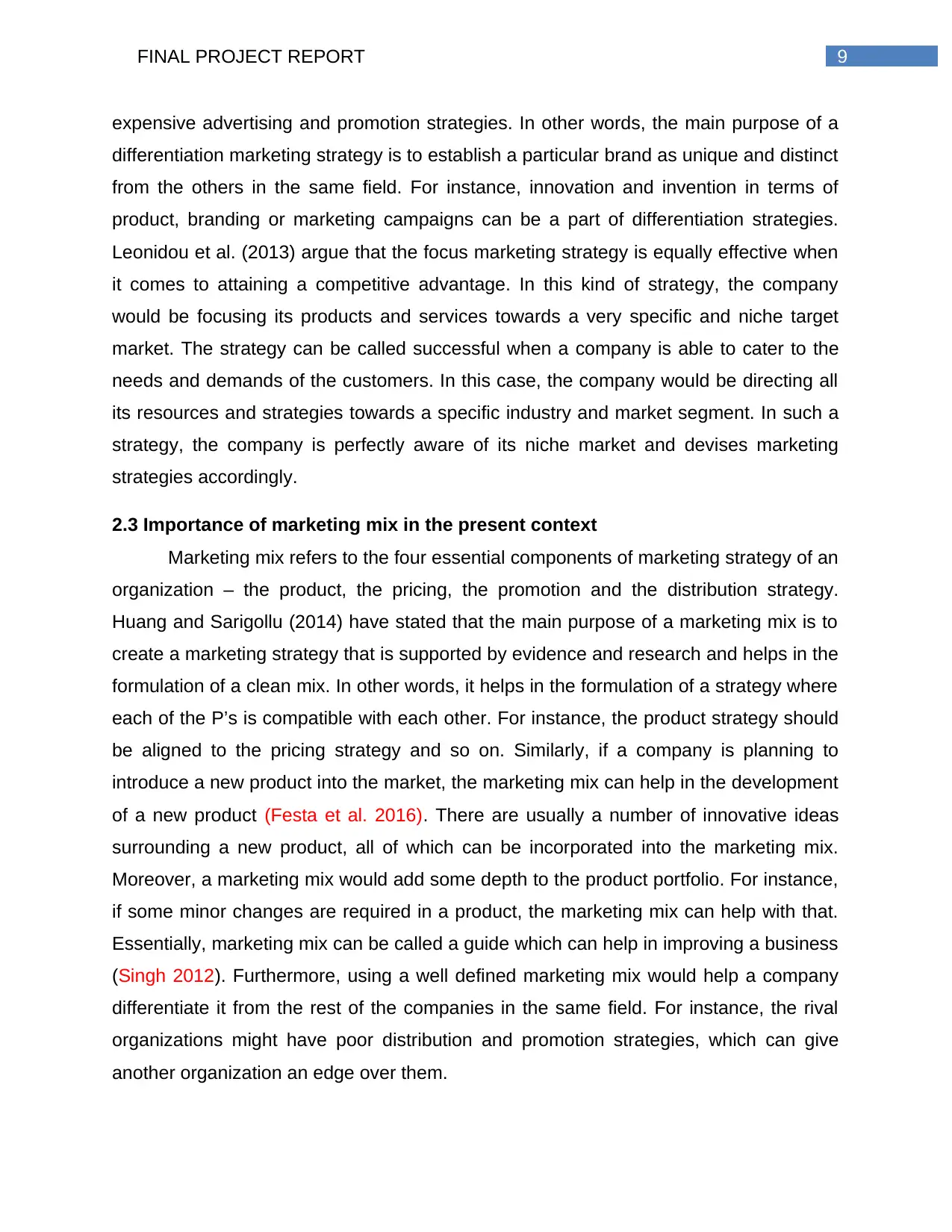
9FINAL PROJECT REPORT
expensive advertising and promotion strategies. In other words, the main purpose of a
differentiation marketing strategy is to establish a particular brand as unique and distinct
from the others in the same field. For instance, innovation and invention in terms of
product, branding or marketing campaigns can be a part of differentiation strategies.
Leonidou et al. (2013) argue that the focus marketing strategy is equally effective when
it comes to attaining a competitive advantage. In this kind of strategy, the company
would be focusing its products and services towards a very specific and niche target
market. The strategy can be called successful when a company is able to cater to the
needs and demands of the customers. In this case, the company would be directing all
its resources and strategies towards a specific industry and market segment. In such a
strategy, the company is perfectly aware of its niche market and devises marketing
strategies accordingly.
2.3 Importance of marketing mix in the present context
Marketing mix refers to the four essential components of marketing strategy of an
organization – the product, the pricing, the promotion and the distribution strategy.
Huang and Sarigollu (2014) have stated that the main purpose of a marketing mix is to
create a marketing strategy that is supported by evidence and research and helps in the
formulation of a clean mix. In other words, it helps in the formulation of a strategy where
each of the P’s is compatible with each other. For instance, the product strategy should
be aligned to the pricing strategy and so on. Similarly, if a company is planning to
introduce a new product into the market, the marketing mix can help in the development
of a new product (Festa et al. 2016). There are usually a number of innovative ideas
surrounding a new product, all of which can be incorporated into the marketing mix.
Moreover, a marketing mix would add some depth to the product portfolio. For instance,
if some minor changes are required in a product, the marketing mix can help with that.
Essentially, marketing mix can be called a guide which can help in improving a business
(Singh 2012). Furthermore, using a well defined marketing mix would help a company
differentiate it from the rest of the companies in the same field. For instance, the rival
organizations might have poor distribution and promotion strategies, which can give
another organization an edge over them.
expensive advertising and promotion strategies. In other words, the main purpose of a
differentiation marketing strategy is to establish a particular brand as unique and distinct
from the others in the same field. For instance, innovation and invention in terms of
product, branding or marketing campaigns can be a part of differentiation strategies.
Leonidou et al. (2013) argue that the focus marketing strategy is equally effective when
it comes to attaining a competitive advantage. In this kind of strategy, the company
would be focusing its products and services towards a very specific and niche target
market. The strategy can be called successful when a company is able to cater to the
needs and demands of the customers. In this case, the company would be directing all
its resources and strategies towards a specific industry and market segment. In such a
strategy, the company is perfectly aware of its niche market and devises marketing
strategies accordingly.
2.3 Importance of marketing mix in the present context
Marketing mix refers to the four essential components of marketing strategy of an
organization – the product, the pricing, the promotion and the distribution strategy.
Huang and Sarigollu (2014) have stated that the main purpose of a marketing mix is to
create a marketing strategy that is supported by evidence and research and helps in the
formulation of a clean mix. In other words, it helps in the formulation of a strategy where
each of the P’s is compatible with each other. For instance, the product strategy should
be aligned to the pricing strategy and so on. Similarly, if a company is planning to
introduce a new product into the market, the marketing mix can help in the development
of a new product (Festa et al. 2016). There are usually a number of innovative ideas
surrounding a new product, all of which can be incorporated into the marketing mix.
Moreover, a marketing mix would add some depth to the product portfolio. For instance,
if some minor changes are required in a product, the marketing mix can help with that.
Essentially, marketing mix can be called a guide which can help in improving a business
(Singh 2012). Furthermore, using a well defined marketing mix would help a company
differentiate it from the rest of the companies in the same field. For instance, the rival
organizations might have poor distribution and promotion strategies, which can give
another organization an edge over them.
Paraphrase This Document
Need a fresh take? Get an instant paraphrase of this document with our AI Paraphraser
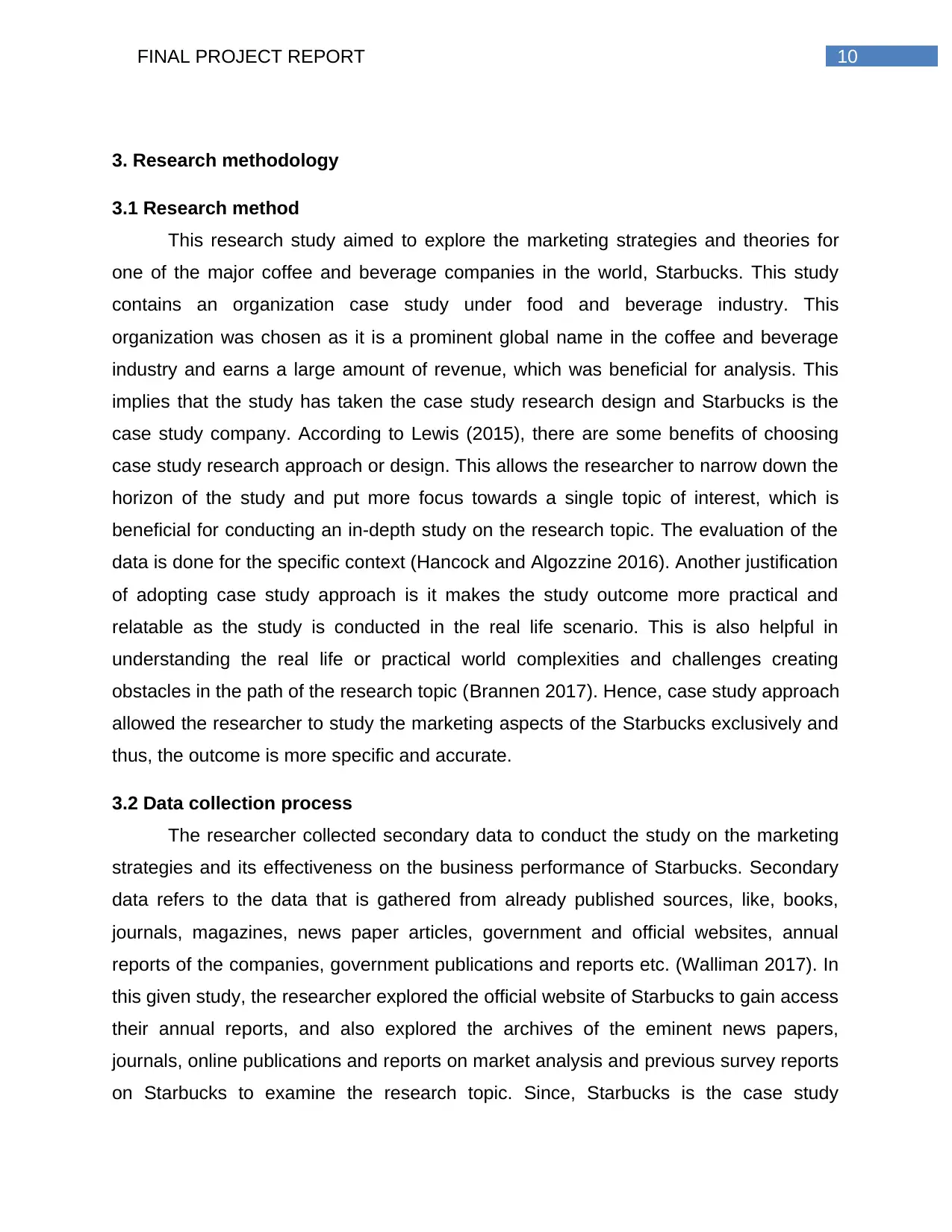
10FINAL PROJECT REPORT
3. Research methodology
3.1 Research method
This research study aimed to explore the marketing strategies and theories for
one of the major coffee and beverage companies in the world, Starbucks. This study
contains an organization case study under food and beverage industry. This
organization was chosen as it is a prominent global name in the coffee and beverage
industry and earns a large amount of revenue, which was beneficial for analysis. This
implies that the study has taken the case study research design and Starbucks is the
case study company. According to Lewis (2015), there are some benefits of choosing
case study research approach or design. This allows the researcher to narrow down the
horizon of the study and put more focus towards a single topic of interest, which is
beneficial for conducting an in-depth study on the research topic. The evaluation of the
data is done for the specific context (Hancock and Algozzine 2016). Another justification
of adopting case study approach is it makes the study outcome more practical and
relatable as the study is conducted in the real life scenario. This is also helpful in
understanding the real life or practical world complexities and challenges creating
obstacles in the path of the research topic (Brannen 2017). Hence, case study approach
allowed the researcher to study the marketing aspects of the Starbucks exclusively and
thus, the outcome is more specific and accurate.
3.2 Data collection process
The researcher collected secondary data to conduct the study on the marketing
strategies and its effectiveness on the business performance of Starbucks. Secondary
data refers to the data that is gathered from already published sources, like, books,
journals, magazines, news paper articles, government and official websites, annual
reports of the companies, government publications and reports etc. (Walliman 2017). In
this given study, the researcher explored the official website of Starbucks to gain access
their annual reports, and also explored the archives of the eminent news papers,
journals, online publications and reports on market analysis and previous survey reports
on Starbucks to examine the research topic. Since, Starbucks is the case study
3. Research methodology
3.1 Research method
This research study aimed to explore the marketing strategies and theories for
one of the major coffee and beverage companies in the world, Starbucks. This study
contains an organization case study under food and beverage industry. This
organization was chosen as it is a prominent global name in the coffee and beverage
industry and earns a large amount of revenue, which was beneficial for analysis. This
implies that the study has taken the case study research design and Starbucks is the
case study company. According to Lewis (2015), there are some benefits of choosing
case study research approach or design. This allows the researcher to narrow down the
horizon of the study and put more focus towards a single topic of interest, which is
beneficial for conducting an in-depth study on the research topic. The evaluation of the
data is done for the specific context (Hancock and Algozzine 2016). Another justification
of adopting case study approach is it makes the study outcome more practical and
relatable as the study is conducted in the real life scenario. This is also helpful in
understanding the real life or practical world complexities and challenges creating
obstacles in the path of the research topic (Brannen 2017). Hence, case study approach
allowed the researcher to study the marketing aspects of the Starbucks exclusively and
thus, the outcome is more specific and accurate.
3.2 Data collection process
The researcher collected secondary data to conduct the study on the marketing
strategies and its effectiveness on the business performance of Starbucks. Secondary
data refers to the data that is gathered from already published sources, like, books,
journals, magazines, news paper articles, government and official websites, annual
reports of the companies, government publications and reports etc. (Walliman 2017). In
this given study, the researcher explored the official website of Starbucks to gain access
their annual reports, and also explored the archives of the eminent news papers,
journals, online publications and reports on market analysis and previous survey reports
on Starbucks to examine the research topic. Since, Starbucks is the case study
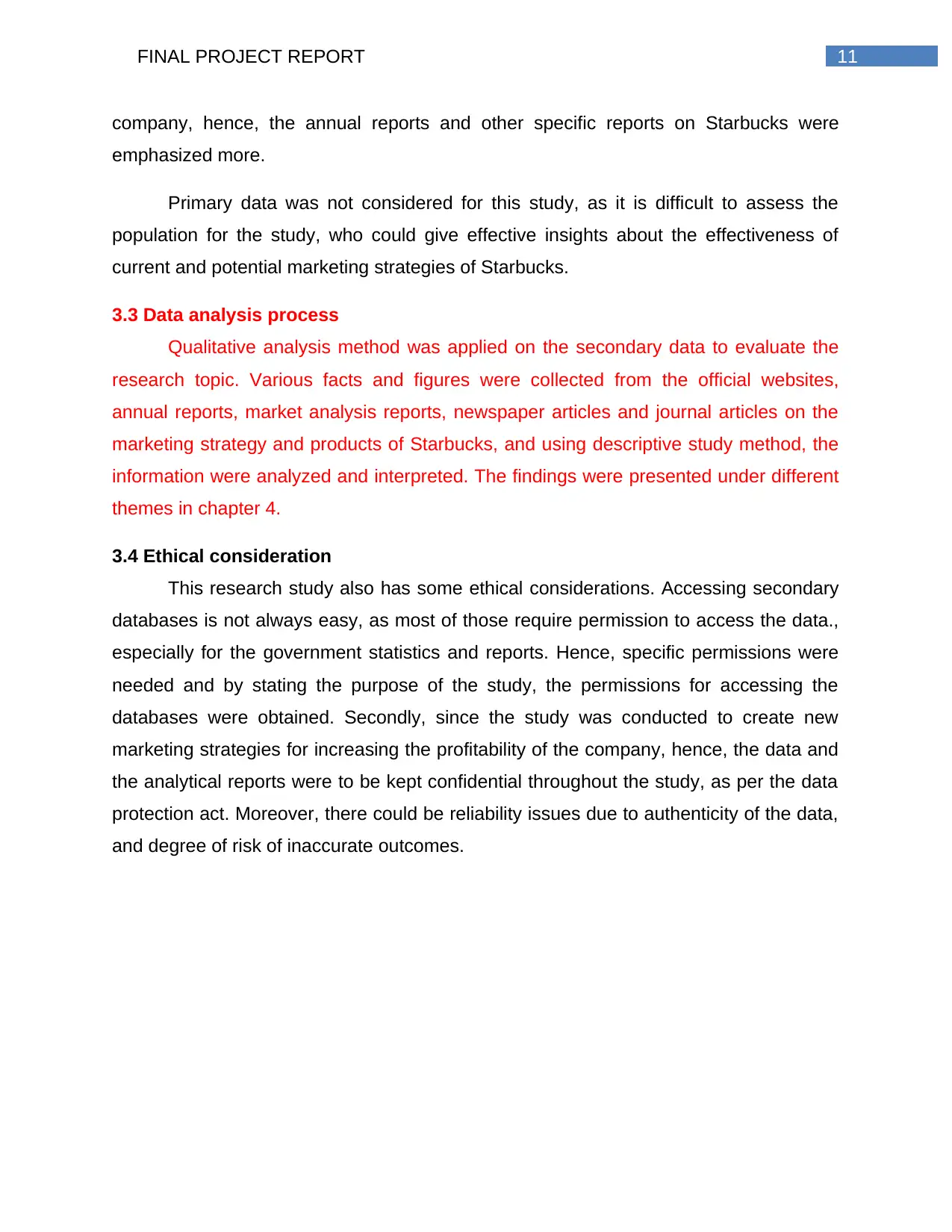
11FINAL PROJECT REPORT
company, hence, the annual reports and other specific reports on Starbucks were
emphasized more.
Primary data was not considered for this study, as it is difficult to assess the
population for the study, who could give effective insights about the effectiveness of
current and potential marketing strategies of Starbucks.
3.3 Data analysis process
Qualitative analysis method was applied on the secondary data to evaluate the
research topic. Various facts and figures were collected from the official websites,
annual reports, market analysis reports, newspaper articles and journal articles on the
marketing strategy and products of Starbucks, and using descriptive study method, the
information were analyzed and interpreted. The findings were presented under different
themes in chapter 4.
3.4 Ethical consideration
This research study also has some ethical considerations. Accessing secondary
databases is not always easy, as most of those require permission to access the data.,
especially for the government statistics and reports. Hence, specific permissions were
needed and by stating the purpose of the study, the permissions for accessing the
databases were obtained. Secondly, since the study was conducted to create new
marketing strategies for increasing the profitability of the company, hence, the data and
the analytical reports were to be kept confidential throughout the study, as per the data
protection act. Moreover, there could be reliability issues due to authenticity of the data,
and degree of risk of inaccurate outcomes.
company, hence, the annual reports and other specific reports on Starbucks were
emphasized more.
Primary data was not considered for this study, as it is difficult to assess the
population for the study, who could give effective insights about the effectiveness of
current and potential marketing strategies of Starbucks.
3.3 Data analysis process
Qualitative analysis method was applied on the secondary data to evaluate the
research topic. Various facts and figures were collected from the official websites,
annual reports, market analysis reports, newspaper articles and journal articles on the
marketing strategy and products of Starbucks, and using descriptive study method, the
information were analyzed and interpreted. The findings were presented under different
themes in chapter 4.
3.4 Ethical consideration
This research study also has some ethical considerations. Accessing secondary
databases is not always easy, as most of those require permission to access the data.,
especially for the government statistics and reports. Hence, specific permissions were
needed and by stating the purpose of the study, the permissions for accessing the
databases were obtained. Secondly, since the study was conducted to create new
marketing strategies for increasing the profitability of the company, hence, the data and
the analytical reports were to be kept confidential throughout the study, as per the data
protection act. Moreover, there could be reliability issues due to authenticity of the data,
and degree of risk of inaccurate outcomes.
⊘ This is a preview!⊘
Do you want full access?
Subscribe today to unlock all pages.

Trusted by 1+ million students worldwide
1 out of 28
Related Documents
Your All-in-One AI-Powered Toolkit for Academic Success.
+13062052269
info@desklib.com
Available 24*7 on WhatsApp / Email
![[object Object]](/_next/static/media/star-bottom.7253800d.svg)
Unlock your academic potential
Copyright © 2020–2025 A2Z Services. All Rights Reserved. Developed and managed by ZUCOL.




